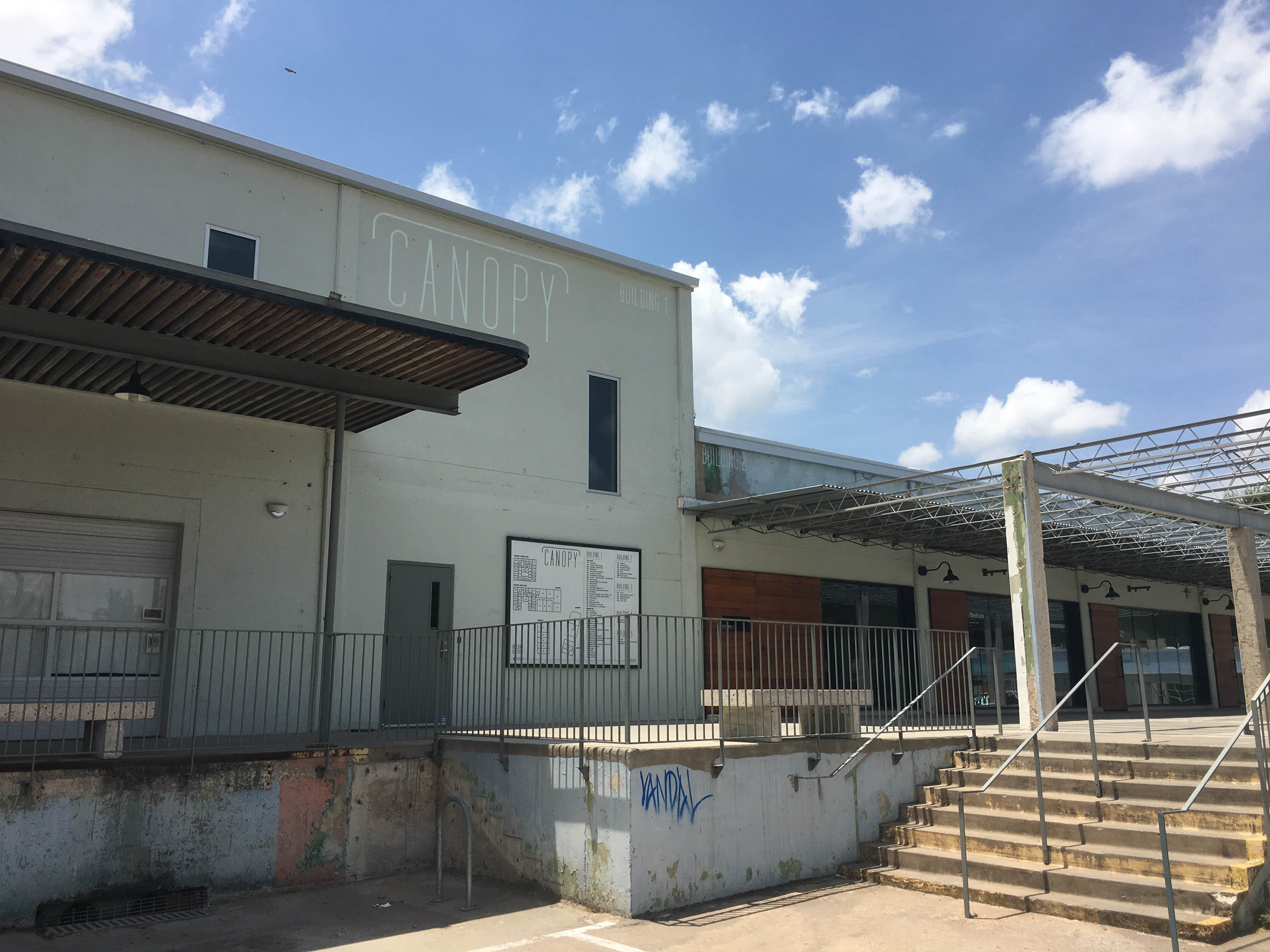
Canopy, located at 916 Springdale Rd, is home to Big Medium and is considered by some to be a pillar of the East Austin Art scene.
“Artists are their own worst enemies.” I didn’t say that; someone involved in the Austin art community did. This person was referring to artists’ tendency to do things for free. The line of reasoning went something like this: artists do things for free, so they don’t generate money, and they subsequently can’t pay their rent. Whether or not this is completely sound or consistent, it does illustrate a key issue facing Austin artists. Due to recent and rapid city development and increased property value, many of them can no longer afford to stay in east Austin.
Over the past several years, art spaces including Up Collective, Tiny Park, and 727 Studio have closed their doors because their landlords realized it was more lucrative to not rent to artists. While they couldn’t outright physically evict their tenants, these landlords financially evicted them by raising rent to current market values. Under the weight of the sudden and steep costs, the art spaces simply couldn’t stand. This is the same story many have heard time and again across most big cities, and it involves the ugly G word: gentrification. East Austin is certainly subject to it.
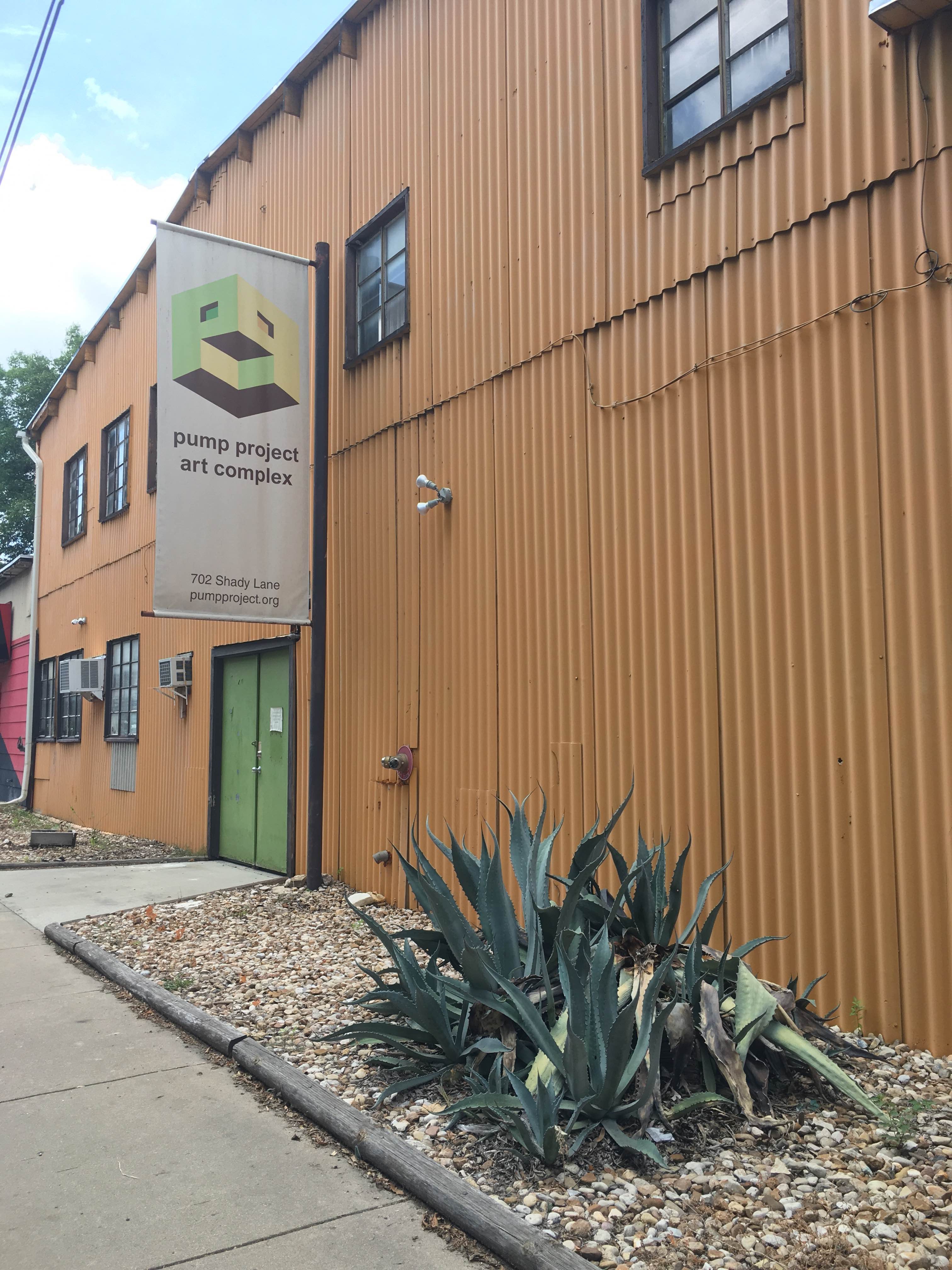
Pump Project Art Complex offers affordable studio spaces to many of Austin’s artists.
But instead of just throwing up hands and bemoaning the situation, Austin’s mayor Steve Adler is trying to stem the fallout from the rising rent tide with his “Austin Music and Creative Ecosystem Omnibus Resolution.” Its purpose is to preserve Austin’s various creative infrastructures because they are seen as a valuable cornerstone of the city’s cultural identity. Passed in mid-March, the resolution came with an urgent timeline requesting the City Manager Marc Ott to present a plan of action to the City Council Economic Opportunity Committee by the beginning of June. Between these dates were a series of committee discussions and town hall meetings focused on identifying various concerns and brainstorming potential solutions.
Serving as a liaison between the City Council and those musicians and artists affected by price-hiking landlords are both the Arts and Music Commissions. Members of these boards were appointed by the City Council and some of them, being practicing artists and musicians, are themselves feeling the economic pressures they are working against. These meetings are historic milestones considering that it’s the first time in recent history that the Music and Arts Commissions have banded together on a cause, and for some, their unification is seen as a long-overdue necessity.
The overall solidarity of this group is still questioned by some. It’s interesting that the resolution’s very title distinguishes between music and other creative ecosystems, as if they are not equally affected by the current challenges of affordability. However, Austin claims to be the “Music Capital of the World,” and I expect some favoritism and jockeying for position is at play regarding the titling and marketing of the resolution. It’s important to remember that the Austin Parks and Recreation department receives 65% of its annual operating budget from Austin City Limits Music Festival. And while some gallery owners are happy to share space with musicians, others are not, and the fact remains that going to an art show is fundamentally different to going to a music or theater performance. Whereas artists are fighting hard for affordable spaces, the musicians I spoke to are more interested in getting paid properly by venues.
As for the resolution itself, the city meeting that I attended focused on a 75-point document divided into the four following subgroups: affordability issues resulting in displacement of musicians and other creatives and their associated places of business; identify and align city of Austin regulations, operations, and incentives to promote the music and creative ecosystems; promote the individual professional development of artists and musicians along with the city’s music and creative industries generally; and develop and promote a continuum of health and education resources for Austin musicians and artists. Outlined underneath each heading are specific points that attempt to consider every possible issue that could be raised. These commissions and city council members appear to have done their homework, and address several of the key issues I heard artists asking for.
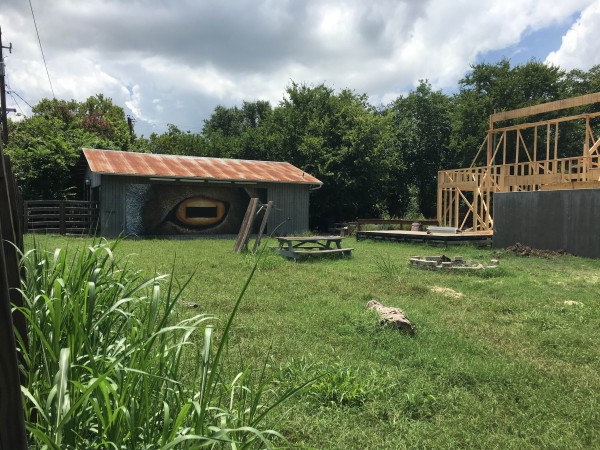
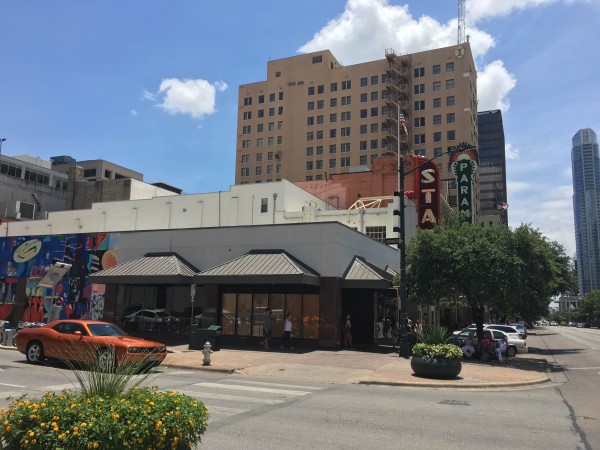
Co-Lab’s old location (top), now under new construction; and Co-Lab’s current location on Congress Avenue (bottom). Co-Lab is leading the way in creative solutions to finding gallery spaces by establishing short-term pop-up locations throughout the city.
For example, under the issue of affordability, the Omnibus proposes solutions including the establishment of music and art hubs through both public and private partnerships as well as working with the appropriate persons to ensure that voter-approved bonds connected with Austin’s creative ecosystems are implemented. The resolution also addresses building codes (another issue that came up) by calling for a reduction in the regulation and zoning barriers to the development of creative spaces. As for available land to use, the Omnibus proposes to appropriate city-owned property for redevelopment as well as develop a density bonus program for the preservation or development of venues in both mixed-use and transit-oriented zones.
And where does the money come from for all of this? Beyond the already mentioned bonds, the Omnibus proposes to explore the feasibility of a loan program and the use of property and sales tax abatements, along with fee waivers, and tax-increment financing to incentivize creative businesses. And this is just the tip of the iceberg. As I mentioned, the proposition is incredibly thorough, and it can be read in full here.

Flatbed Press located at 2830 E Martin Luther King Jr Blvd, that houses several local galleries and hosts different workshops, is watching a new high rise go up across the street.
The extent of this proposal is daunting, and that makes it feel a little like a laundry list to some of the gallery and studio directors I spoke to. They feel that this document is closer to a blanket summary of solutions never to see the light of day than anything that can be actually implemented. There is also a concern that many of the members of the commissions and councils are failing to grasp the urgency of the resolution. Several people who I spoke to clearly feel that all of this is five years too late, and is now only being passively toyed with as an appeasement device. There is a subtle, but clear, mistrust of the government here. But then again, musicians and artists often exist as countercultures, and mistrust of Big Brother is in their blood. The main issue comes down to some measured value of creative output, which is contingent on funding and community involvement.
How do you assign worth to art and music? Both are valuable, but how much, and to what end? Depending on whom you’re talking to, the economic value of art may or may not come into play. Several of the gallery and studio directors want to sidestep this potentially loaded conversation by focusing on the local community. Through different outreach and education programs, they are invested in generating art’s social worth that legitimizes the proposed financial funding. By opening art spaces up to the non-art crowd, they (theoretically) become an asset to a larger population, and are subsequently more desirable for the city to support and developers to consider. (This ‘social worthiness’ factor is a refrain in gentrification conversations across the country.)
The issue of developers (and their agendas) is one that is met with caution by many. Given many current developers’ track records of demolishing existing structures and building high rises with no allowance for creative spaces, many of the people I spoke to would rather go at it alone. This involves purchasing land, hiring an architect, and designing a space that fits the needs of the artists and performers. It also gets at the heart of huge issue embedded in all of this: should these artists and musicians leave east Austin?
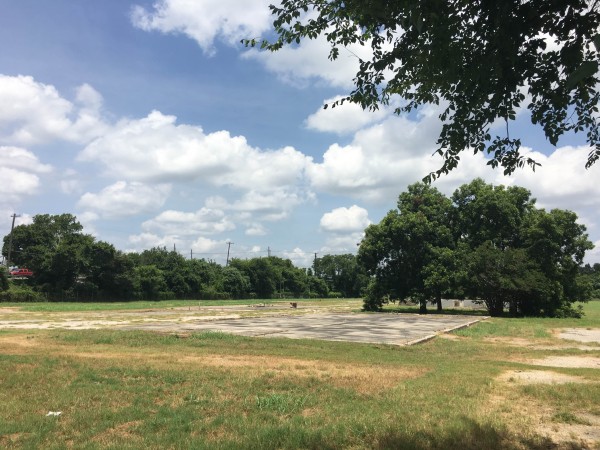
This vacant lot, located at the intersection of Airport Blvd and Springdale Rd, is one of the proposed sites for creating a new art hub called thinkEAST.
Proposed by some and rejected by others, this migration involves galleries and studios moving to places like Dell Valley or Elgin where they could build their own art hubs and establish collectives as they see fit. Such a move has the potential to completely eliminate the studios’ and galleries’ current major source of stress: being at the mercy of their landlords. It removes power from an overseer who may not understand the ‘value’ of art, and puts it in the hands of those who do. But many of the gallery and studio directors call east Austin home and feel they have contributed to making the neighborhood what it is. Having invested all of that time and energy into a neighborhood they clearly love and are dedicated to only to move on and start over elsewhere seems unappealing and unfair. It’s the seemingly inevitable sad ending of the age-old gentrification cycle, and one they’d like to work around. So some of these directors are proposing to establish hub locations in east Austin, and are even pointing to land that is available and could be turned to that purpose.
Over the next five to ten years, the Omnibus resolution, or parts of it, will play out (or not), as will current art space leases. And I’m sure that whatever solutions are implemented by the city, or its artists, east Austin—like the rest of the city—will not look the way it looks right now.



14 comments
Austin government would benefit greatly by communicating with Artspace, based in St. Paul, to develop affordable artist’s work/live spaces. Artspace has a long track record of developing these spaces in conjunction with local lenders. There is a new building opening in El Paso, there is an existing development in Houston….why not Austin? It’s one thing to come up with a resolution, it’s another to act creatively and keep our artistic community intact.
http://www.temp.artspace.org/about
The city of Austin has been in communication:
https://austintexas.gov/department/economic-development-reports-publications
Artspace Preliminary Feasibility Report (2010)
Artspace Market Survey Report (2013)
thanks, this is good to know, are there any projects that are actually in process for Austin?
Maybe:
http://www.austinchronicle.com/daily/arts/2015-04-03/thinking-thinkeast/
http://www.austinchronicle.com/arts/2016-04-15/austin-creative-alliances-summit-report/
http://www.mystatesman.com/news/news/local/land-with-history-of-false-starts-may-become-austi/nqLXj/
Buy, don’t rent.
As a former resident of Studio 727, I appreciate the effort made to bring this issue to the surface. Nevertheless, that opening paragraph is hard to swallow. At 727, they more than than tripled our rent, and used a number of harassment techniques to make it impossible for us to work. Would anyone be able to afford more than 3x what they pay for rent? And “market value” – would you pay $3 a square foot for a mice-infested run-down warehouse space that floods inside every time it rains? More attention to detail is needed here.
Del Valle
(not Dell Valley)
Thank you.
In 1994 I was living in New York and we visited exotic Williamsburg to see an artist loft/exhibition space, which was in a huge warehouse. The neighborhood was dead, just a couple of pierogi places to eat. I had never heard of the L train before. When artists make the neighborhood cool, eventually landlords triple, quintuple, centuple the rents. Always has been, always will be. Blaming them is a waste of time.
Unfortunately for this latest effort in Austin, I’m afraid that rent control — even in the service of artists — is not the answer. It’s tenure for real estate and it will create the same ferocious fight for underpriced resources, and the same mediocrity. Think about what municipally-funded artist housing will look like in 20 years. It’s not pretty, and it’s certainly not where the energy is.
Rent control is not really an option.
“Texas has no ‘rent control’ laws that limit the amount of rent increases.”
http://www.housing-rights.org/myths.html
Tax-subsidized housing, rent control, tomato, tomahto.
Think it through: who decides which artists get to live in these places? What’s going to happen to your work when you have to justify your artistic life to a committee of bureaucrats (and a philanthropist and curator, if you’re lucky) in order to hang onto your artificially low rent?
Artists should (and do) look to create the opportunities of the future, not fight to recreate those of the past.
Actually,
Tomato, tomato.
I’m agreeing with you:
“Artists should (and do) look to create the opportunities of the future, not fight to recreate those of the past.”
If there was any “cultural capital” amongst the new affluence that has invaded Austin, there wouldn’t be an issue with supporting “The Arts” in Austin.
Rather than leaving for Elgin, or almost leaving for Del Valle, there is a lot of space in Central N Austin, in the Rundberg/Rutland/I35-Burnet Rd. area, also up Cameron Road & elsewhere in NE Austin…. Lots of great opportunities for some very cool community outreach and funding too. Austin is in a ridiculously heady boom cycle right now, but that doesn’t mean there aren’t overlooked areas that provide lots of cheap potential… It’s unfortunate but it’s like the writer above mentioning Williamsburg. Greenwich Village was cheap in the ’50’s… I desperately hate seeing people leave town. Please stay! Just be a little more open minded for solutions.